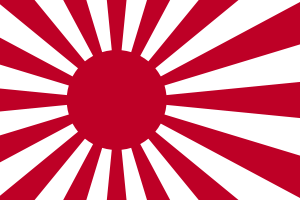Special Naval Landing Forces
| Special Naval Landing Force (SNLF) 海軍特別陸戦隊 Kaigun Tokubetsu Rikusentai | |
|---|---|
|
The ensign of the Special Naval Landing Force | |
| Active | 1928–1945 |
| Country |
|
| Allegiance | Emperor of Japan |
| Branch |
|
| Type | Marines |
| Role | Amphibious warfare |
| Engagements |
Sino-Japanese War Soviet-Japanese border conflicts World War I World War II |
| Commanders | |
| Notable commanders | Commander Masajiro Hayashi |
The Special Naval Landing Forces (SNLF), (海軍特別陸戦隊 Kaigun Tokubetsu Rikusentai) were the marine troops of the Imperial Japanese Navy (IJN) and were a part of the IJN Land Forces. They saw extensive service in the Second Sino-Japanese War and the Pacific theatre of World War II.
History
.jpg)
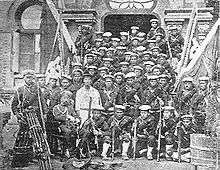
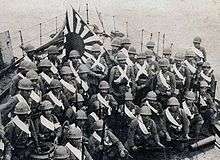
Before the late 1920s the IJN did not have a separate marine force, instead it used naval landing forces or rikusentai formed from individual ships's crews, who received infantry training as part of their basic training, for special and/or temporary missions.
In the late 1920s the navy began to form Special Naval Landing Forces as standing regiments (albeit of battalion size). These forces were raised at — and took their names from — the four main naval districts/bases in Japan: Kure, Maizuru, Sasebo, and Yokosuka. These SNLF units saw action in China from 1932 in the January 28 Incident and at the Battle of Shanghai in naval operations along the China coast and up the Yangtze River and its tributaries during the Second Sino-Japanese War.[1] Soon, they became involved in successful Japanese seaborne assaults throughout South East Asia.
Other SNLF were later raised from IJN personnel in China, at Hankow, and Shanghai, for service in Canton and on the Yangtze River. On 7 December 1941 there were 16 SNLF units, this increased to 21 units during the war. The strengths of each SNLF ranged from the prewar peak of 1,200 to a later 650 personnel. There was also a special detachment in the Kwantung area, garrisoning the ports of Dairen and Ryojun.
Initially, the SNLF were not a marine force, but was instead sailors who had basic infantry training and were employed in landings during the Russo-Japanese War and the Boxer Rebellion. Soon their training and equipment were improved upon drastically, and their forces were given a variety of other operations as well.[1] In 1941, the 1st, 2nd and 3rd Yokosuka SNLF were converted to parachute units. They conducted more combat drops than Japanese Army parachute units during World War II.[2] The SNLF paratroopers were used during the attack on Celebes and the Battle of Manado, to much lauded success by the Imperial government. Aside from the paratroopers, there were also elite squads who conducted reconnaissance and raid operations.
Since then, the Landing Forces has been influential in Japan's expansion of territories, and their tactics of surprising their enemies through sea invasions proved effective.[2] The original SNLF personnel were well-trained, high quality troops with good morale and they performed well against opposition across Southeast Asia. However, like all landing forces they often experienced heavy casualties when faced with determined resistance, such as at the invasion of Timor and the Battle of Milne Bay. This is due to their unwillingness to surrender, and when completely out of ammunition, they would often resort to hand-to-hand fighting with their swords and bayonets. To combat highly defended positions in the Pacific, the Landing Forces created new tactics and techniques in order to overcome them, that would later be adopted by the Allied in their sea-borne invasions.[2][3]
In a well known last stand in 1943, 2,619 men of the 7th Sasebo SNLF and 2,000 base personnel at the Battle of Tarawa accounted for over 3,000 U.S. Marine Corps casualties.
SNLF Units
Infantry Units
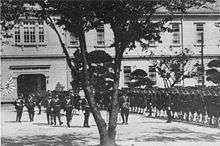
- Kure Naval Base
- 1st Kure SNLF-At Hainan Naval District, 3rd China Fleet
- 2nd Kure SNLF
- 3rd Kure SNLF
- 5th Kure SNLF
- 6th Kure SNLF
- 7th Kure SNLF
- Maizuru Naval Base
- 1st Maizuru SNLF
- 2nd Maizuru SNLF
- 4th Maizuru SNLF
- 5th Maizuru SNLF
- Sasebo Naval Base
- 1st Sasebo SNLF
- 2nd Sasebo SNLF-Under 32nd Special Base Force, 3rd Fleet
- 5th Sasebo SNLF
- 6th Sasebo SNLF
- 7th Sasebo SNLF
- 8th Sasebo SNLF Shanghai Naval Base (Operated along the Yangtze river, China)
- Sasebo Combined SNLF (Combined 1st and 2nd Sasebo SNLF)
- Yokosuka Naval Base
- 1st Yokosuka SNLF (Originally an SNLF Para formation)
- 2nd Yokosuka SNLF
- 3rd Yokosuka SNLF (Originally an SNLF Para formation)
- 4th Yokosuka SNLF
- 5th Yokosuka SNLF
- 6th Yokosuka SNLF
- 7th Yokosuka SNLF
Special Guard Detachments
- Ryojun SNLF: special naval guard detached in Ryojun port, Kwantung belonged in Ryojun Guard District.
- Shanghai SNLF (746 men): special naval guard based in Shanghai port, China belonged in China Theater Fleet. Later merged into Canton Special Base Force based in Guangzhou area.
- Yangtze SNLF: special river squadron detached along the Yangtze river area inside of 1st China Fleet.
- Hankow SNLF: special naval guard based in Hankow and Wuchang ports,belonged to Middle River Division,inside Yangtze River Fleet and 1st China Fleet.
- Canton SNLF: special naval guard detached in Guangzhou port, Kwangtung belonged inside of Canton Special Base Force.
Paratroopers of the SNLF
See article:Japanese marine paratroopers of World War II
- Yokosuka Naval Base
Tank and Armor Units
See article:Imperial Japanese Navy Armor Units
- Shanghai SNLF Tank Company
- Milne Tank Platoon of Kure 5th SNLF
- Tarawa Tank Unit of Sasebo 7th SNLF
- Kwajalein Armor Unit of Sasebo 7th SNLF
- Navy tank unit of 55th Guard Unit,Yokosuka 1st SNLF
- Itoh Armored Detachment SNLF
- Makin Armor SNLF Detachment of Navy 3rd Special Base Force
SNLF Training Units
- SNLF infantry training centers: Located in main bases of Kure, Maizuru, Sasebo, Yokosuka along special training centers of Ryojun and Dairen in Kantogun.
- SNLF paratrooper school: Recruits were trained at the army/navy paratrooper training base on Kanto Plain.
- SNLF land armor school: Created in the Tateyama IJN Ordnance School that was across from Tokyo on the Boso Peninsula.
- SNLF amphibious armor school: Was established in the IJN aquatic armour unit at Q-Base on Nasakejima in 1943 and the first trained units were sent to Rabaul (New Guinea) and the Marshall Islands in October of same year.
Uniforms of the SNLF
Service dress
On board ship the sailors of the SNLF wore their standard IJN blue or white uniforms but when on land the SNLF wore a uniform similar to that of the Imperial Japanese Army. The land uniform consisted of a green single breasted tunic with a stand and fall collar with three buttons which ran down the front. The SNLF usually wore this uniform with the collar open over the IJN's white trimmed teeshirt and officers wore it with a shirt and tie. The tie was originally dark blue but was later changed to green. Green long trousers or pantaloons were worn as standard along with the wool puttees or leather gaitors. All, except mounted troops (who wore breeches and high leather boots), wore this uniform with horsehide, pigskin or leather ankle-boots.
SNLF Paratroopers wore two types of green uniform made from rip stop parachute silk with built in bandoleers and cargo pockets, being better designed than other paratrooper models of the time.
Originally green rank insignia was used for SNLF officers. These were worn on either shoulder boards or collar tabs. Enlisted men wore red on green round ratings on the upper sleeves. Later the standard black Japanese Naval collar rank was adopted and worn by officers. The enlisted men went to red on blue round ratings.
The ankle boots had either a hobnailed hard leather sole with metal heel J-cleat or a rubber sole with rubber cleats. When off duty, sailors could wear tabis. A collarless wool or cotton white, gray or light green undershirt was worn under the tunic. This had one or two patch breast pockets with buttoned flaps, most had only a single pocket on the left breast. A khaki cotton shirt with stand and fall collar and two breast pockets could be worn in warm climates, with or without the tunic. The flat-topped sailor's cap was replaced by a cloth field cap with a short leather or (more usually) cloth peak.
SNLF officers were not usually issued uniforms so they had to procure their own, thus there was a wide variety in the details, color and texture of their uniforms, with uniform colors ranging from pale to dark green. Collars were stiffer and materials were of a higher quality. All ranks later wore a single breasted version of the IJA M98. Officers could wear straight trousers with their M98 uniforms as a walking out uniform and later they could also wear the tunic with the collar open over a white or gray green shirt.
Headgear
The Adrian helmet was replaced by the Navy Type 2 and later the Type 3. Both were variants of the IJA Type 92 (1932). It was officially called tetsubo (steel cap) but was called tetsukabuto ("steel helmet") by troops. It was made in the shape of a dome with a short protruding rim all the way around it the IJN's Type 2 had a less flared rim. This helmet was made of a thin inferior chrome-molybdenum steel with many proving to be very fragile, being easily pierced by shrapnel and/or gunfire. The IJN Type 3 was even thinner and made cheaper than the Type 2. An anchor for the IJN was fixed to the front with two bendable prongs attached to the back of the badge. They passed through a slit in the front of the shell and were then bent over to secure the badge to the helmet. The helmet and anchor were then painted one of many shades of green. They were sometimes whitewashed in the winter. A tan cover known as a first pattern was a two layer, fiber reinforced linen cover with a wool/felt two piece anchor sewn on the front. The second pattern cover was a shade of green. It had a one piece bevo woven anchor insignia sewn onto its front. Nets were then used to add a camo effect. The helmet was secured to the head by an elaborate set of straps descended from those of the Kabuto samurai helmet, although IJN helmet tapes were tied differently from the way the IJA tied them. It was also able to be worn over a field cap. Camouflage nets were widely worn over the helmet especially in the Southern theatre and Pacific island campaign.
- Tropical helmet -
- Type 90 - was like the cork helmet issued by the European imperial powers. It had a metal ventilator at the top, a couple of ventilation eyelets on either side and a brown leather chinstrap. It was mostly worn by officers.
- Type 92 - This was a cork version of the Type 92 steel helmet. It was covered with six segments of cloth, and several versions were available. It was issued to all ranks. Officers usually wore a white cover on theirs. A similar helmet was later worn by the Viet Cong.
Other Items

The IJN issued single-breasted over coats, capes and raincoats with hoods in olive drab.
- Senninbari (千人針) were a red-sash 1,000 stich belt worn around the waist of their uniforms. They were supposed to bring good luck, confer courage, and make the wearer immune from bullets.
- Hachimaki (鉢巻) is a stylized headband (bandana) in the Japanese culture, usually made of red or white cloth, worn as a symbol of perseverance or effort by the wearer.
- Fatigues - White cotton fatigues were initially issued as a tropical uniform but then when a light-khaki(tan) was adopted as a hot weather uniform colour, the fatigues were originally worn over the standard uniform to keep it clean while doing dirty-work. Later an olive green version of the white fatigues was issued.
- Bousyo-i/Tropical - The tropical cotton uniform, designed similar to the M98, were initially available in tan or light khaki, but were superseded later in the war by versions in medium to dark green. They had open collars, buttoned side vent flaps below the armpits, pleated patch or internal pockets with flaps. Trousers could be full-length, 3/4 length, or a loose fitting breeches style pantaloon. The usual uniform worn in the Pacific islands was knee length shorts worn with a lightweight cotton shirt, which had three front buttons, 3/4 length sleeves and patch breast pockets with flaps. Officers wore a short or long sleeved lightweight white (or off-white) tropical shirt with the green trousers. When they wore the green tropical tunic they usually wore the shirt collar outside and over the tunic collar.
- Kessenfuku/Battle Dress - A waist length jacket with two hidden slash breast pockets, and two internal pockets with flaps. It also had a fold-down collar and reinforced elbows. Cheaper materials were used in fabrication with many variations in material and color.
Weapons of the SNLF
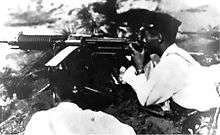
Heavy weapons
- 75mm regimental guns
- 70mm Type 92 Gun
- 3-inch (76mm) naval guns mounted on wheeled carriages
- Type 97 81mm Infantry Mortar
- Type 11 37 mm Infantry Gun
- Type 94 37 mm Anti-Tank Gun
- Type 1 37 mm Anti-Tank Gun
- Type 1 47 mm Anti-Tank Gun
- Type 92 13.2 mm AA machinegun on a twin mount
- 25 mm shipboard AA gun adapted for land use

Armor and Tanks
- Naval Type 88 Tankette (Carden Loyd tankette)
- Type 92 Heavy Armoured Car (tankette)
- Type 89 "Chi-Ro" Medium Tank
- Type 95 "Ha-Go" Light Tank
- Type 97 "Chi-Ha" Medium Tank
- Type 97 "Shinhoto Chi-Ha" Medium Tank
- Short Barrel 120 mm Gun Tank
- Type 2 Amphibious Tank "Ka-Mi"
- Type 3 Amphibious Tank "Ka-Chi"
- Type 5 Amphibious Tank "To-Ku"
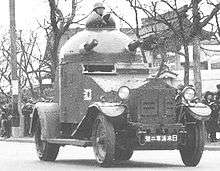
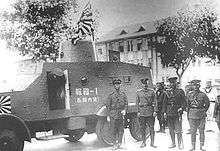

APCs and Armored Cars
- Vickers Crossley model 1925 Armored Car
- Type 2592 Chiyoda Armored Car
- Sumida M.2593 Armored Car
- Type 93 Armoured Car a/k/a Type 2593 Hokoku, Type 93 Kokusanor or "Type 92" naval armored car
- Type 4 Ka-Tsu Amphibious APC Vehicle
Amphibious Trucks and Land Trucks
- Type 95 Mini-truck
- Toyota Amphibious Truck "Su-Ki"
Infantry Weapons
- Type 92 bipod-mounted MGs
- Type 92 13.2 mm heavy machine gun
- Type 3 heavy machine gun
- Type 92 heavy machine gun
- Arisaka rifles
- Type I Rifle
- Hamada, Nambu pistols and Type 26 revolvers
- Sugiura pistol
- MP 18 and MP 28 submachine guns
- Type 100 submachine gun
- Model 2 submachine gun
- Light Mortars
- Handgrenades
- Grenade launchers
- Grenade launcher rifle
- Light AT weapons
- Flamethrowers
- Military swords
- Bayonets
See also
- Naval ranks of the Japanese Empire during World War II
- 海上機動旅団(Sea Landing Brigades) - Japanese Wikipedia article [Not translated]
References
- 1 2 Pacific Files
- 1 2 3 Japanese Special Naval Landing Forces
- ↑ Rose, Lisle A. , Power at Sea, Volume 2: The Breaking Storm, 1919-1945, University of Missouri (December 30, 2006) p. 141. ISBN 978-0826217028
- 1 2 Donaldson, Graham (1999–2000). "The Japanese paratroopers in the Dutch East Indies, 1941-1942". Forgotten Campaign: The Dutch East Indies Campaign 1941-1942.
- Sources
- Imperial Japanese Army and Navy Uniforms and Equipment by Tadao Nakata and Thomas B. Nelson
- Imperial Japanese Army and Navy Uniforms and Equipments by Lionel Leventhal Limited
- United States Army's TM-E 30-480 Handbook On Japanese Military Forces
External links
| Wikimedia Commons has media related to Special Naval Landing Forces. |
- Yaklitch, Alsleben and Takizawa. "Japanese Special Naval Landing Forces". The Netherlands East Indies 1941-1942.
- L, Klemen (1999–2000). "Japanese Uniforms, 1941-1942". Forgotten Campaign: The Dutch East Indies Campaign 1941-1942.
